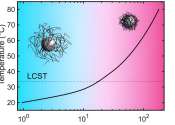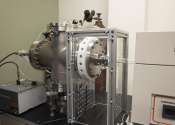Last update:
Nanophysics news

Quantum-inspired design boosts efficiency of heat-to-electricity conversion
Researchers at Rice University have found a new way to improve a key element of thermophotovoltaic (TPV) systems, which convert heat into electricity via light. Using an unconventional approach inspired by quantum physics, ...
Nanophysics
Nov 21, 2024
0
51

Novel framework allows for tunable ultrasound propagation in microscale metamaterials
Acoustic metamaterials—architected materials that have tailored geometries designed to control the propagation of acoustic or elastic waves through a medium—have been studied extensively through computational and theoretical ...
Nanophysics
Nov 21, 2024
0
64

Physicists develop new method to visualize magnetic nanostructures with high resolution
A new method enables researchers to analyze magnetic nanostructures with a high resolution. It was developed by researchers at Martin Luther University Halle-Wittenberg (MLU) and the Max Planck Institute of Microstructure ...
Nanophysics
Nov 20, 2024
0
53

Light-matter interaction reveals new paradigm of quantum information technology
A research team led by Professor Jaedong Lee from the Department of Chemical Physics of DGIST has introduced a novel quantum state and a pioneering mechanism for extracting and controlling quantum information using exciton ...
Nanophysics
Nov 19, 2024
0
28

New ion speed record holds potential for faster battery charging and biosensing
A speed record has been broken using nanoscience, which could lead to a host of new advances, including improved battery charging, biosensing, soft robotics and neuromorphic computing.
Nanophysics
Nov 19, 2024
0
96

Electron imaging reveals the vibrant colors of the outermost electron layer
Surfaces play a key role in numerous chemical reactions, including catalysis and corrosion. Understanding the atomic structure of the surface of a functional material is essential for both engineers and chemists. Researchers ...
Nanophysics
Nov 18, 2024
0
21

New on-chip device uses exotic light rays in 2D material to detect molecules
Researchers have developed a highly sensitive detector for identifying molecules via their infrared vibrational "fingerprint." This innovative detector converts incident infrared light into ultra-confined "nanolight" in the ...
Nanophysics
Nov 18, 2024
0
15

Designing a spiral ladder-inspired tool that allows precision control of light direction and polarization
Photonics is the study of the generation, detection, and manipulation of light waves in the form of photons. One interesting property of light is polarization, defined by its electric and magnetic fields oscillating in any ...
Nanophysics
Nov 14, 2024
0
19

How are nanostructures created? Imaging techniques unveil secrets of electrodeposition
Metallic nanoparticles, consisting of a few to several thousand atoms or simple molecules, are attracting significant interest. Electrodes coated with layers of nanoparticles (nanolayers) are particularly useful in areas ...
Nanophysics
Nov 13, 2024
0
1

Macroscopic C₅₄₀ model offers new way to study sound wave propagation in topological metamaterials
Researchers have taken a novel approach to studying the interaction between certain topological metamaterials and sound wave propagation.
Nanophysics
Nov 12, 2024
0
42

Researchers unveil proximity-induced electrical transport properties of Pt/CrI₃ heterostructure
Two-dimensional magnetic materials have remarkable potential applications in spin switches and storage devices. Designing innovative device architectures and exploring their electrical transport characteristics are becoming ...
Nanophysics
Nov 8, 2024
0
9

Physicists reveal how layers and twists impact graphene's optical conductivity
When it comes to electrically conductive nanomaterials, graphene—stronger and lighter than steel and more conductive than copper—has been shown to be an excellent choice for a wide range of technologies.
Nanophysics
Nov 7, 2024
0
120

New approach for tuning current flow in 2D MOF nanosheets shows promise for advanced electronics
Researchers led by Prof. Cunlan Guo at Wuhan University have pioneered a new approach to control the electrical properties of two-dimensional (2D) metal-organic frameworks (MOFs), specifically porphyrinic 2D MOF nanosheets, ...
Nanophysics
Nov 7, 2024
0
17

Quasiperiodicity changes the ground-state properties of 1D narrow-band moiré systems, study demonstrates
Moiré materials, such as twisted bilayer graphene, are materials generally formed by stacking two or more layers of 2D materials on top of each other with a small lattice mismatch. This slight mismatch creates a unique pattern ...

A single atom can change the directional profile of the light emitted in scanning tunneling microscopes
Researchers from Madrid explain a phenomenon that allows the direction of light emission to be controlled at the atomic scale. The paper provides a detailed explanation of how the profile of the light collected in a scanning ...
Nanophysics
Nov 5, 2024
0
1

Researchers develop high-quality nanomechanical resonators with built-in piezoelectricity
Researchers at Chalmers University of Technology in Sweden and at the University of Magdeburg in Germany have developed a novel type of nanomechanical resonator that combines two important features: high mechanical quality ...
Nanophysics
Nov 5, 2024
0
62

Unlocking next-gen chip efficiency: Researchers confirm thermal insights for tiny circuits
In a leap toward more powerful and efficient computer chips, researchers at the University of Virginia have confirmed a key principle governing heat flow in thin metal films—a critical component in the race to design faster, ...
Nanophysics
Nov 4, 2024
0
66

Chiral molecular self-assemblies that absorb light boost singlet fission process, research demonstrates
In organic molecules, an exciton is a particle bound pair of an electron (negative charge) and its hole (positive charge). They are held together by Coulombic attraction and can move within molecular assemblies. Singlet fission ...
Nanophysics
Nov 1, 2024
0
68

Fundamental quantum model recreated from nanographenes
The smallest unit of information in a computer is the bit: on or off, 1 or 0. Today, the world's entire computing power is built on the combination and interconnection of countless ones and zeros. Quantum computers have their ...
Nanophysics
Oct 31, 2024
0
60

Researchers observe stick-slip phenomenon in carbon nanotube fibers
The shapes of simple polyatomic molecules such as carbon dioxide and methane are characterized by a specific symmetry depending on the manner of linking of the atoms. Nano- to micrometer-sized particles that mimic the shapes ...
Nanophysics
Oct 30, 2024
0
0
Other news

Keeping a cell's nucleolus compact may be key to fighting aging

Uranus's swaying moons could help spacecraft seek out hidden oceans

Family matters: Living near relatives makes us heroic and harsh

Framework uncovers what makes large numbers of 'squishy' grains start flowing in biological processes

New mechanism in bacterial DNA enzyme opens pathways for antibiotic development

More comprehensive search for sterile neutrinos comes up empty































































